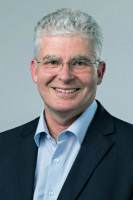Klaus Hecker is Managing Director of the OE-A (Organic and Printed Electronics Association), which was instrumental in organizing the LOPEC trade fair and the LOPEC Congress in Munich. The OE-A is an international working group within the VDMA.
 Dr. Klaus HeckerTheLOPEC impressively demonstrated the progress made in printed and organic electronics. What are the most important trends at the moment?
Dr. Klaus HeckerTheLOPEC impressively demonstrated the progress made in printed and organic electronics. What are the most important trends at the moment?
Flexible electronics are still on the rise, right up to the foldable smartphone. The trend is now towards stretchable materials that are suitable for applications in medicine, sport and clothing. In the mobility sector, electric cars and autonomous driving are opening up opportunities for printed sensors, integrated control and interface systems and further developments in battery technology. Production processes conserve resources and are more energy-efficient than conventional electronics, and the use of printed electronics for energy-efficient surface heating in cars, for example, can save weight and therefore fuel.
Hybrid systems combine printed and silicon-based components. Where do you see overlaps with 'classic' PCB technology?
Printed electronics enable the cost-effective production of a wide variety of large-area sensor arrays, OLED surfaces or solar cells, for example. These flexible electronics can be combined with small, high-performance silicon chips for reading out and processing the extensive data generated by such a sensor foil. New assembly and connection technologies are also used here to reliably connect rigid and flexible components. However, we are also seeing growing interest in films with printed conductor paths in combination with classic components.


